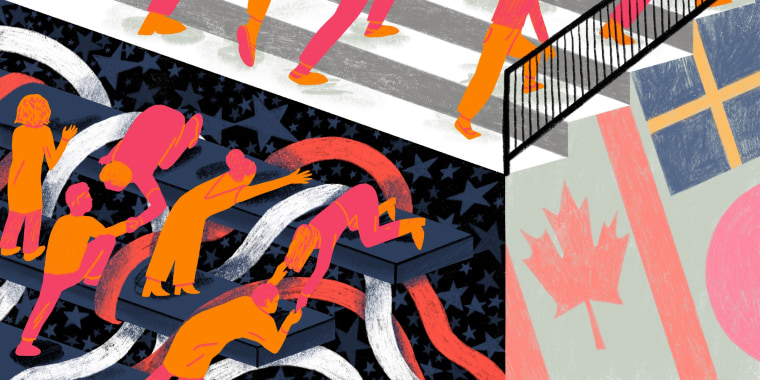The pandemic's ripple effect on job mobility, unemployment rates and even paid leave has given Americans a better picture of the country’s work-life policies. And when it comes to workers' benefits, the U.S. trails behind several leading developed nations across the globe.
From paid sick leave and parental leave to paid vacation days and unemployment benefits, here’s a look at employee services the U.S. provides in comparison to a handful of nations leading the social service charge.
Paid sick leave:
According to the Center for Economic Policy and Research, the U.S. is the only developed country that does not guarantee paid sick leave in any capacity; however, some states, such as New York and California have statewide mandates.
Australia
The CEPR report shows that Australia requires employers to cover earnings employees lost during a short-term illness. This means if any given worker is absent for 10 days, employers must provide 100% of pay to workers with no waiting period or ceiling.
Canada
If employees undergo sickness, injury or quarantine, Canada provides employment insurance, which gives workers benefits for a maximum of 15 weeks, the report shows. If workers qualify, benefits include 55% of their salary; however, according to CEPR, low-income families can qualify for the Employment Insurance Family Supplement, which can increase benefits to at most 80% of their typical earnings.
Ireland
Something unique about Ireland is that the government requires employers to include paid sick leave in their contracts, the CEPR report shows.
Japan
If workers don’t have coverage at their own place of work, Japan provides Employee’s Health Insurance for those eligible, per CEPR. While there is a three-day waiting period, workers can receive these benefits for a maximum of 18 months at 66.67% of their average earnings.
Parental leave:
According to the Organization for Economic Cooperation and Development (OECD), The U.S. is one of the only developed nations that does not require employers to provide any paid leave to new parents. Some states, however, including Rhode Island and New Jersey, require paid family leave, a National Conference of State Legislatures report says.
Sweden
If you’re wondering which nation has one of the highest numbers of required parental leave days, look no further. In Sweden, when a child is born or adopted, parents receive 480 days of paid parental leave at 80% of their average wage. Both parents get a respective 90 days out of those 480, so they can individually bond with their child.
Finland
Finland’s women-led government recently drafted a proposal for family leave reform that is currently under governmental review. The reform looks to take steps toward “gender equality for working life.” What exactly does this mean? All parents have the same number of family leave days regardless of gender. Unlike traditional maternity leave frameworks, Finland’s new proposal aims to provide families with leave that can either be taken by one of the parents or shared by both.
Australia, New Zealand, Iceland and Sweden
As a result of policies that limit paternity leave, research shows that same-sex male couples often have limited paid family leave times compared to other couples. According to the Journal of Social Policy, of 33 countries that mandate paid parental leave, Australia, New Zealand, Iceland and Sweden are the only nations that offer same-sex male couples the same amount of leave as different-sex couples. How do they go about this? In parental leave laws, these governments use gender-neutral language to ensure all parents of adopted and non-adopted children are entitled to equal leave.
Paid vacation days:
In the U.S., when it comes to vacation days, employers and employees lay out those terms in their individual contracts. After the first year of working at any given company, workers typically get an average of 10 paid vacation days.
United Kingdom
Not only does the U.K. mandate paid vacation leave for workers, but they also enforce that full-time employees receive at least 28 days a year.
France
If you’re searching for a country with high paid vacation leave, France is a clear winner. Each year, the government mandates workers receive at least 30 working days of paid holiday leave. France even has an agency, the National Agency for Holiday Vouchers, that encourages workers to indulge in leisure activities and leave.
Unemployment benefits:
While the U.S. federal government expanded unemployment aid during the pandemic, most unemployment insurance rates vary by state. For example, the average weekly rate in Massachusetts is as high as $521.24, while the average weekly rate in Arkansas is $248.70.
Luxembourg
Luxembourg provides workers with relatively high unemployment benefits. Eligible employees are entitled to 80% of their former gross salary. Families get perks, too: If workers have custody of at least one child, they are entitled to 85% of their former gross salary.
Slovenia
According to the 2013 Unemployment Benefits in EU Member States report, Slovenia is the only member nation that doesn’t have a maximum-earnings ceiling. So, within the first three months, unemployed citizens are entitled to 80% of their former earnings with no maximum limit.

